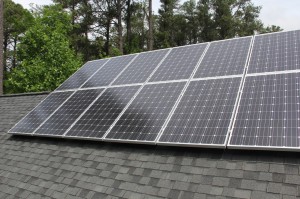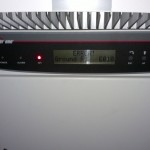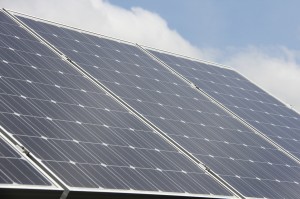Tomorrow will be two weeks since our solar panels were installed by Southern Energy Management. When we first got them, I jokingly complained on Facebook how the panels only lasted 12 hours and then quit working. Some of my friends caught on to my joke (it was nighttime) right away while others scratched their heads.
Unfortunately, it’s no longer a joke. Twice over the last week the inverter has failed with a ground fault error, indicating a wiring problem in the panel side of system. What’s more, last week the main breaker tripped, indicating a problem with the grid side of the system. A tech came out on Tuesday and wrapped tape around a nick in the AC cable’s insulation which fixed the breaker issue but the panels are still down until the ground fault gets fixed.
For anyone considering getting a solar PV system, the best advice I can provide you is to be patient. It is a long wait until anything even gets put on your roof. Then the install itself can take a couple of weeks, depending on the difficulty, weather, crew availability, and other potential setbacks. Finally, even if all the parts are supposedly in place, there still might be work to do in ironing out the kinks, as we have found out this week.
On several days I made arrangements to work from home during this process, taking time away from the office that would have been very beneficial to me in my new position. The same work could have been accomplished in half the time had the communication and coordination been better. I don’t think my time was considered as valuable as it probably should have been.
Communication was also a problem. We got handed off to various crews who evidently don’t talk to each other. The first technician who came out to scope out the project needs didn’t tell the next technician (who ran conduit) what the plans were. The conduit guy had to start from scratch. He did a very good job, mind you, with what he had to work with but ran the conduit to the wrong place relative to the future panels. The team installing the panels replaced half the conduit and moved it further up the roof.
We were handed off to a project coordinator, which would ordinarily be a wise move and cut down on confusion but in our case was of little help. Day one of the panel install I was assured the team would only be there for “a few hours and gone by lunch.” Um, no. It took multiple days to complete the roof deck installation.
Once the gear was in place, the project coordinator scheduled an electrical inspection, which (understandably, this time) required me to be home. We needed two inspections, however: electrical and building, and a city building inspector showed up a few hours later thinking he would be doing the final on the project. By that time the SEM tech was long gone, and the inspection had to be rescheduled for this morning. The inspector required the consulting engineer to seal his building plans before the inspector would sign off on the project. I was told by SEM this was highly unusual.
Then the ground fault issue hit us last week. I let our project coordinator know about it and asked for a tech to be sent out to fix it. The tech who arrived knew nothing of the problem and had to be told by Kelly what the issue was.
Yesterday morning, I wrote the project coordinator about the latest ground fault and asked that a tech look at it today. The coordinator came out this morning for the final building inspection and, after the inspector had departed, asked to see the inverter, declared it needed fixing and that a crew would be out on Tuesday, and then left. I essentially wasted a day I could’ve spent in the office for something I could’ve accomplished with my smartphone’s camera. It was very frustrating.
Oh, and our project coordinator was not aware that our “certificate of completion” had been sent this week to the power company. If you’re the project coordinator and you don’t even know when a project you’re supposedly coordinating is complete, you might not be doing your job right.
The only bright side to this is how quickly Duke Energy Progress came out and installed our new bidirectional meter. My fellow solar PV owner, Jason Hibbets, said it took Progress Energy eight weeks to put in his meter. Ours came well within a week of filing our completion papers. That’s the way to underpromise and overdeliver!
So, what would we do differently?
Better project management. I chose Southern Energy thinking they would provide us with expert service. I’m not sure what we got was expert service. Too many pieces seemed to fall through the cracks, so to speak, to give me confidence in them. Having a real project manager would have made all the difference in this regard. There are other solar installers out there, so find one that also excels at customer service.
Better contract terms. We paid the full price near the front end of the project. The SEM salesperson told us they needed the 12-months same as cash loan signed over at the start yet the bank providing the loan stressed to pay it only at project completion. Thus our “12 months same as cash” was whittled down by two months. Also, we wrote our last check at the completion of the “material installation” stage but in hindsight should have insisted that the last payment occur only once we were fully satisfied and all inspections had been completed and passed. Dumb, dumb, dumb. You should treat getting solar PV system like closing on a house: only when you’re completely satisfied with the work should the bill get paid in full.
Overall, we’re pleased to be joining the solar revolution. We’re the envy of the neighborhood, with many neighbors contemplating their own moves to solar. No matter what promise our panels bring us, though, they’re just very expensive roof ornaments if they’re not creating electricity. The thrill of going solar will start flowing as soon as the electrons do.


